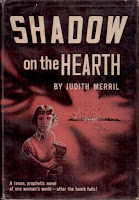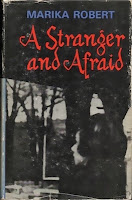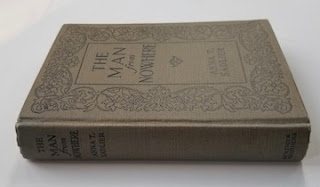Queen Kong
James Moffatt
London: Everest, 1977
172 pages
James Moffatt ranks as one of Canada's most prolific novelists – second only to romance writer W.E.D. Ross – but where Ross is pretty much forgotten, even amongst aficionados of the nurse novel (his speciality), Moffatt has developed a remarkably strong cult following. His greatest achievement – and biggest sellers – were commissioned works designed to exploit skinhead culture. The first, Skinhead (1970), written in his late forties, was followed by Suedehead (1971), Boot Boys (1972), Skinhead Escapades (1972), Skinhead Girls (1972), Top Gear Skin (1973), Trouble for Skinhead (1973), Skinhead Farewell (1974), and Dragon Skin (1975). Moffatt churned them out amongst dozens of other novels, my favourite being 1973's Glam.
A paperback writer, Moffatt is thought to have written close to three hundred published novels. He shared the secret to his prolificity in a 1972 interview with the BBC:
JM: I like to sit down in front of a typewriter - start writing from the title. Play it by that. The title gives me the idea, it gives me the whole germ of the story, and I continue it right through.In the lengthy James Moffatt bibliography, Queen Kong stands out as an oddity. His lone movie novelization, it challenged the author's method. Here Moffatt was obliged to follow a plot laid down by screenwriters Frank Agrama and Ronald Dobrin.
BBC: How many words a day do you get through?
JM: On an average, I get through about ten thousand words a day, when I'm meeting a deadline. If I have a month to write a book in, I may get through five hundred, a thousand words a day, until the last week - then I shot up to the ten thousand.
BBC: Do you ever go back and rewrite stuff?
JM: I never go back and rewrite. I don't believe in editing. I don't believe in rereading more than two pages on the following day. I believe a professional writer should have the story in his head, even if he's doing two, three stories at the one time. He should keep all story threads in his head.
Queen Kong was meant to exploit King Kong, the 1976 blockbuster starring Jeff Bridges and Jessica Lang. RKO and producer Dino De Laurentiis were not amused. Arguing before Justice Goulding, their solicitor, Nicholas Brown-Wilkinson, the future Baron Brown-Wilkinson, expressed their distaste:"Our view is that it is an appalling script. It is a script which the plaintiffs feel cannot do anything but repercuss poorly on their reputation if it is thought that King Kong is associated with that."
The lawyer for Dexter Films, which had sunk US$635,000 into Queen Kong, countered that the film was a "light-hearted satire." In this, I think, they encountered an unexpected response from Justice Goulding: "I do not think that in any real sense the relationship of Queen Kong to King Kong can be said to be that of La belle Hélène to The Iliad. King Kong was not a serious work. It was a film of pure, light-hearted entertainment spiced with horror."
And there you have it, Queen Kong cannot be considered a light-hearted satire of King Kong because King Kong itself is light-hearted; the two are just too similar.
I can't argue.
Queen Kong owes more to the Merian Cooper and Ernest Schoedsack 1933 original, than the 1976 remake. As the title suggests, much of the humour derives from role reversal. It stars Rula Lenska as Luce Habit, a tough-as-nails director in search of a leading man for her next motion picture. She finds one in Ray Fay (Robin Askwith), a petty thief with no acting experience, whom she spots in a London market. Luce drugs Ray, carries him to an awaiting ship, The Liberated Lady, and sets sail for the African nation of Lazanga, Where They Do The Conga. Once there, its native population – primarily women, primarily white, almost invariably blonde – kidnap Ray as a human sacrifice to a gigantic female gorilla they call Kong.
However, Kong falls in love with the would-be actor, keeping him safe and healthy while Luce and her all-female crew plan a rescue. In the ensuing scenes, Kong is captured, is transported to London, and is put on display in chains, bra, and panties. At the event, Luce and Ray do the dance of Lazanga, Where They Do The Conga, upsetting the creature. Kong breaks her bonds and goes on a rampage through the city, destroying buildings and one low-flying 747. She manages to find Ray, and saves him from being molested by Luce in an upscale hotel room. Kong climbs Big Ben, and sets Ray down. He uses a helicopters loudspeaker to call off the attack:
"You cannot destroy her, for she represents all women everywhere; women forced into a mould to satisfy the images of male chauvinism. If you destroy this beautiful beast, you're destroying a lifetime of female struggle. Yes, she represents woman; woman struggling to find her identity in a society viewing her as a kitchen slave and sex object."Ray's speech is lengthy, but effective. The women of London take to the streets, saving Kong, and transforming society forever. Kong is returned to Lazanga, Where They Do The Conga, with Ray, leaving sad, cast-off Luce tearily hoping that Ray would be interested in a threesome.
For the most part, Moffatt follows Agrama and Dobrin's script, making use of nearly all their dialogue, no matter how bad. These lines, from the novel, are virtually identical to those delivered by Lenska, as Luce, in the film:
"Through the genius of the Kodak laboratories I am able to make home movies that look like the professional films one sees during the second half of the bill in any local cinema. However, the fault with the majority of home movies is that people just smile and wave into the camera lens. In my award-winning pics nobody waves at the camera. That's what I'm famous for – not one wave!"
Even as she finished speaking a gigantic wave hit the small boat, whooshed over the decks and drenched Luce.
"Well," the Habit ruefully admitted, "maybe one wave!"
As might be expected, there is padding, the most obvious being the inclusion of "SOHO", a 48-line prose poem by someone named Tomi Zauner. But the most interesting – and jarring – difference between the film and the novelization concerns the depiction of Ray Fay. Where the film has him as as an asexual pot-head, who looks like a member of The Sweet...
...Moffatt portrays him as a homosexual hippie.
The Ray Fay of the film has no backstory. Moffatt adds a fumbled tumble with a teenage girl, which leaves him with a preference to men. Gay Ray Fay is a "fag" – the word appears dozens of times in the novel – and he's not the only one. The men of Lazanga, Where They Do The Conga are gay, and as Luce laments, "half the blokes you met in London are also queens."
Luce Habit pursues her leading man, dressing Ray in robes and feathered boas, while she wears pant-suits and tuxedos. This passage from the novel, which follows a spanking administered by the director, does not feature in the film:
Ray, unable to keep up his lung-torturing scream, felt himself go all limp – \wrists, too. Like a sad sack he tilted forward into Luce's welcoming arms.This scene does:
I'll protect you Ray, Luce whispered, hugging him to her gorgeous bosom.
"Oh, God!" the star-in making moaned, feeling queer all over.
A man with the nicest, cleanest bone through his nose rushed from a hut – and called in a bush-telegram voice" "Oh, Mr Tarzan... Mr Tarzan – your wife Jane is on the vine!"Moffatt's ending is different to that of the film in that suggestions of bisexuality and beastialty do not figure. The final chapter ends with Luce Habit going to bed with her female talent agent.
Ray declined to accept the call although he trembled in an anticipation off a Tarzan-Fay link-up. What a Western Union that would be!
He roamed deep into the village complex. The hits with bamboo supports fascinated him. Thatched roofs a la Dorset village cuteness appealed. Weren't they quaint! What looked to be a village queen's hut loomed large in his sights. He had a feeling about these things. He peered inside, found a villager scrubbing a toilet bowl. The old male "dear" swung, faced him, black teeth in an otherwise normal white set glistening.
"Make your toilet as clean as your mouth," the native fag smiled, thrusting an Ajax bottle at Ray.
The agent's name is Ima Goodbody.
A thoroughly dislikable novelization to a terrible movie, it's not redeemed by a happy ending.
Trivia: Frank Agrama and Ronald Dobrin collaborated on just one other film: Dawn of the Mummy (1981). It concerns scantily dressed fashion models who disturb an ancient Egyptian tomb.
Dedication and Acknowledgement:
Object: A mass market paperback featuring eight glossy pages of film stills. The author's name is misspelled on both the front cover and spine. The back cover gives indication that the book was sold in Canada, though I've yet to come across a copy. I purchased mine last year from a UK bookseller. Price: £4 (with a further £9 for shipping).
Access: WorldCat lists five libraries with copies, none of which are in Canada. The closest to me is held in the Folke Bernadotte Memorial Library of Gustavus Adolphus College in St Paul, Minnesota.
Beware the British bookseller who entices by offering a Fair copy at one American dollar – and then charges US$24.95 for shipping.
Queen Kong – the Sensational Film – can be seen here on YouTube.
Related post:














































